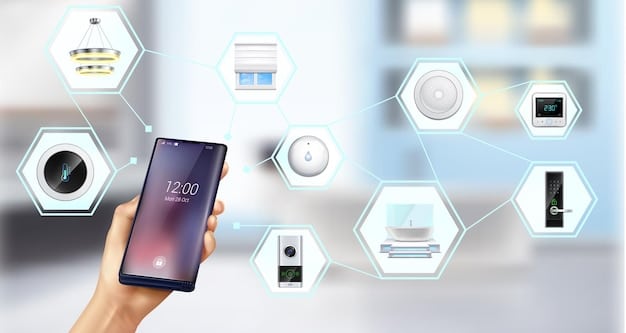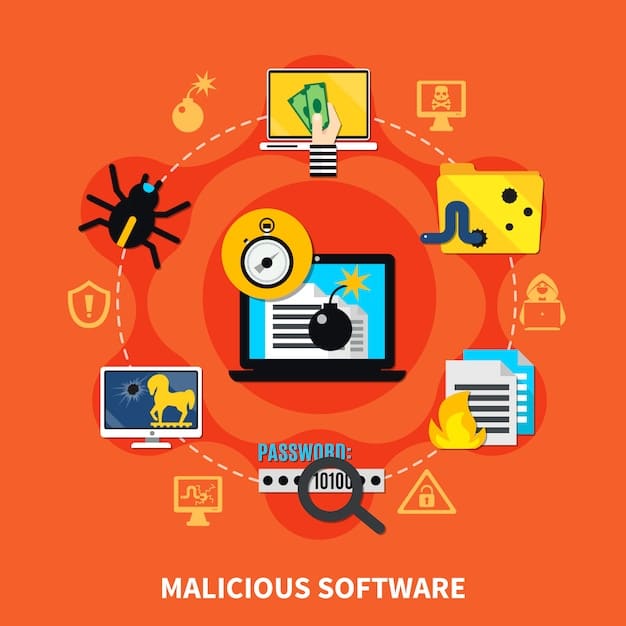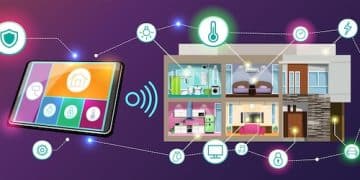DHS Warns of Rising IoT Cybersecurity Threats: A Comprehensive Analysis

The US Department of Homeland Security (DHS) has issued a warning highlighting the escalating cybersecurity threats targeting Internet of Things (IoT) devices, emphasizing the need for increased vigilance and robust security measures.
The US Department of Homeland Security Issues Warning on Emerging IoT Cybersecurity Threats, underscoring the urgent need for individuals and organizations to bolster their defenses against potential vulnerabilities in connected devices.
Understanding the DHS Warning on IoT Cybersecurity
The US Department of Homeland Security (DHS) has recently issued a stark warning regarding the burgeoning cybersecurity threats that are targeting Internet of Things (IoT) devices. But what exactly does this warning entail, and why is it so critical?
This warning underscores the increasing prevalence and sophistication of cyberattacks aimed at exploiting vulnerabilities within IoT ecosystems.

The Scope of the IoT Threat Landscape
The Internet of Things (IoT) has become an integral part of modern life, with billions of devices connected globally. This hyper-connectivity, however, also significantly expands the attack surface for cybercriminals. Several factors contribute to the broad scope of the IoT threat landscape:
- Device Proliferation: The sheer number of IoT devices, ranging from smart home appliances to industrial sensors, presents numerous entry points for attackers.
- Security Vulnerabilities: Many IoT devices are designed with minimal security considerations, making them susceptible to exploitation.
- Lack of Updates: Many users fail to update their devices regularly, leaving known vulnerabilities unpatched and exploitable.
Moreover, the interconnected nature of IoT devices means that a single compromised device can serve as a gateway to an entire network, amplifying the potential damage.
Key Vulnerabilities in IoT Devices
Identifying the vulnerabilities within IoT devices is crucial for understanding the DHS warning. Common security flaws include:
- Weak Passwords: Many devices come with default passwords that are easily guessed or remain unchanged by users.
- Unencrypted Data: Sensitive data transmitted by IoT devices may not be properly encrypted, making it vulnerable to interception.
- Software Bugs: Like any software-driven device, IoT devices can contain bugs that can be exploited by malicious actors.
Addressing these vulnerabilities requires both manufacturers and users to prioritize security measures from the outset.
In summary, the DHS warning highlights the comprehensive nature of IoT cybersecurity threats, urging stakeholders to take proactive measures to mitigate risks. The rapid proliferation of IoT devices and their inherent vulnerabilities necessitate a heightened awareness and robust security posture.
Types of Cybersecurity Threats Targeting IoT Devices
The ever-expanding universe of Internet of Things (IoT) devices has ushered in an era of unprecedented connectivity, but it has also introduced a myriad of cybersecurity threats. Understanding the specific types of attacks targeting these devices is crucial for effective mitigation.
Cybercriminals are continually refining their tactics to exploit vulnerabilities in IoT devices, making it imperative to stay informed about the latest threats.

Common Attack Vectors
Several types of attacks are commonly used against IoT devices. These include:
- DDoS Attacks: Distributed Denial of Service (DDoS) attacks involve overwhelming a device or network with traffic, rendering it inaccessible.
- Malware Infections: IoT devices can be infected with malware designed to steal data, disrupt operations, or even recruit the device into a botnet.
- Phishing Scams: Cybercriminals use phishing techniques to trick users into revealing sensitive information that can be used to compromise IoT devices.
Each of these attack vectors can have significant consequences, ranging from data breaches to complete system shutdowns.
Real-World Examples of IoT Attacks
To illustrate the real-world impact of IoT cybersecurity threats, consider the following examples:
- Mirai Botnet: In 2016, the Mirai botnet used compromised IoT devices, such as security cameras and routers, to launch massive DDoS attacks that disrupted major websites and services.
- Smart Home Hacks: Reports have surfaced of hackers gaining access to smart home devices, such as baby monitors and security cameras, to spy on occupants.
- Industrial Control Systems: Attacks on industrial control systems (ICS) connected to the IoT can disrupt critical infrastructure, leading to power outages, water contamination, and other catastrophic events.
These examples underscore the importance of securing IoT devices to prevent real-world harm.
In conclusion, the types of cybersecurity threats targeting IoT devices are diverse and evolving. From DDoS attacks and malware infections to phishing scams, cybercriminals are continually devising new ways to exploit vulnerabilities. Staying informed about these threats and implementing robust security measures is essential for protecting IoT ecosystems.
Who is Affected by IoT Cybersecurity Threats?
The impact of IoT cybersecurity threats extends far beyond individual devices, affecting a wide range of stakeholders across various sectors. Understanding who is at risk is crucial for implementing targeted security measures and mitigating potential damage.
From consumers and businesses to critical infrastructure providers, the ripple effects of IoT security breaches can be substantial.
Consumers and Home Networks
Consumers are increasingly vulnerable to IoT cybersecurity threats as smart devices become commonplace in homes. Risks include:
- Privacy Breaches: Hackers can gain access to personal information through compromised smart devices, such as cameras, microphones, and fitness trackers.
- Financial Loss: Cybercriminals can exploit vulnerabilities in smart devices to steal financial information or conduct fraudulent transactions.
- Home Network Compromise: A single compromised IoT device can serve as a gateway to the entire home network, exposing other devices and data.
Consumers need to be aware of these risks and take steps to secure their IoT devices and home networks.
Businesses and Enterprises
Businesses and enterprises face unique challenges in securing IoT devices, particularly in industrial and commercial settings. Risks include:
- Data Breaches: IoT devices used in business operations can expose sensitive data to cybercriminals, leading to financial losses and reputational damage.
- Operational Disruption: Attacks on IoT devices can disrupt business operations, causing downtime and lost productivity.
- Supply Chain Vulnerabilities: Compromised IoT devices in the supply chain can expose businesses to risks from third-party vendors and partners.
Businesses need to implement robust security measures to protect IoT devices and integrate them into existing cybersecurity frameworks.
In summary, IoT cybersecurity threats affect a wide range of stakeholders, from consumers and home networks to businesses and critical infrastructure providers. The interconnected nature of IoT devices means that a security breach in one area can have cascading effects, highlighting the need for comprehensive and proactive security measures across all sectors.
How to Mitigate IoT Cybersecurity Risks
Mitigating IoT cybersecurity risks requires a multifaceted approach that involves both manufacturers and users. Implementing proactive security measures is essential for protecting IoT devices and preventing potential breaches.
By adopting best practices and staying informed about the latest threats, individuals and organizations can significantly reduce their exposure to IoT-related risks.
Best Practices for IoT Security
Several best practices can help mitigate IoT cybersecurity risks:
- Secure Device Configuration: Change default passwords, enable encryption, and disable unnecessary services on IoT devices.
- Regular Software Updates: Keep IoT devices updated with the latest security patches and firmware to address known vulnerabilities.
- Network Segmentation: Segment the network to isolate IoT devices from critical systems, preventing a single compromised device from affecting the entire network.
These practices provide a foundation for securing IoT devices and protecting against common threats.
The Role of Manufacturers and Developers
Manufacturers and developers play a critical role in IoT security by:
- Incorporating Security by Design: Build security into the design and development process, rather than adding it as an afterthought.
- Providing Timely Updates: Offer regular security updates and patches for IoT devices to address vulnerabilities and protect against emerging threats.
- Secure Data Handling: Implement secure data handling practices to protect sensitive information collected by IoT devices.
By prioritizing security, manufacturers and developers can help build a more secure IoT ecosystem.
In conclusion, mitigating IoT cybersecurity risks requires a collaborative effort between manufacturers and users. By adopting best practices, implementing proactive security measures, and staying informed about the latest threats, individuals and organizations can significantly reduce their exposure to IoT-related risks.
The Role of Government and Industry Standards
Government agencies and industry organizations play a crucial role in shaping the landscape of IoT cybersecurity through the development and enforcement of standards and regulations. These efforts aim to establish a baseline level of security for IoT devices and promote best practices across the industry.
Understanding the regulatory environment and adhering to industry standards is essential for ensuring the security and compliance of IoT devices.
Government Initiatives and Regulations
Government agencies are increasingly focused on IoT security, with initiatives and regulations aimed at:
- Establishing Security Standards: Developing and promoting security standards for IoT devices to ensure a minimum level of protection against cyber threats.
- Enforcement of Regulations: Enforcing regulations to hold manufacturers accountable for the security of their IoT devices.
- Public Awareness Campaigns: Launching public awareness campaigns to educate consumers about the risks of IoT devices and how to protect themselves.
These initiatives aim to improve the overall security posture of the IoT ecosystem.
Industry Standards and Certifications
Industry organizations also contribute to IoT security through the development of standards and certifications, such as:
- ISO Standards: The International Organization for Standardization (ISO) has developed standards for IoT security, providing guidance on best practices and risk management.
- NIST Guidelines: The National Institute of Standards and Technology (NIST) has published guidelines for securing IoT devices, offering practical recommendations for manufacturers and users.
- Industry Certifications: Various industry certifications, such as those offered by the IoT Security Foundation, provide assurance that IoT devices meet certain security standards.
Adherence to these standards and certifications can help organizations demonstrate their commitment to IoT security.
In summary, government agencies and industry organizations play a crucial role in shaping the landscape of IoT cybersecurity through the development and enforcement of standards and regulations. These efforts aim to establish a baseline level of security for IoT devices and promote best practices across the industry, fostering a more secure and resilient IoT ecosystem.
Future Trends in IoT Cybersecurity
As the Internet of Things (IoT) continues to evolve, so too will the landscape of cybersecurity threats and the measures needed to counter them. Keeping abreast of future trends is crucial for staying ahead of potential risks and ensuring long-term security.
Emerging technologies and evolving threat vectors will necessitate a proactive and adaptive approach to IoT cybersecurity.
The Rise of AI and Machine Learning in IoT Security
Artificial intelligence (AI) and machine learning (ML) are poised to play an increasingly important role in IoT security by:
- Threat Detection: AI and ML algorithms can analyze vast amounts of data to identify patterns and anomalies that may indicate a cyberattack.
- Automated Response: AI-powered systems can automatically respond to threats, isolating compromised devices and implementing security measures to prevent further damage.
- Predictive Security: ML models can predict future threats based on historical data and trends, allowing organizations to proactively address vulnerabilities before they are exploited.
These applications of AI and ML offer a powerful defense against sophisticated IoT attacks.
The Importance of Zero Trust Security
The zero trust security model is gaining traction in the IoT space as a more effective approach to protecting against cyber threats. Key principles of zero trust include:
- Verification: All users and devices must be verified before being granted access to resources, regardless of their location or network.
- Least Privilege: Users and devices are granted the minimum level of access required to perform their tasks, limiting the potential impact of a security breach.
- Continuous Monitoring: The IoT environment is continuously monitored for threats, and security measures are adapted as needed.
By implementing zero trust principles, organizations can significantly reduce their exposure to IoT cybersecurity risks.
In conclusion, the future of IoT cybersecurity will be shaped by emerging technologies and evolving threat vectors. The rise of AI and machine learning, coupled with the adoption of zero trust security models, will be crucial for staying ahead of potential risks and ensuring the long-term security and resilience of the IoT ecosystem.
| Key Point | Brief Description |
|---|---|
| ⚠️ DHS Warning | Highlights rising IoT cybersecurity threats. |
| 🛡️ Mitigation | Secure device configuration, updates, network segmentation. |
| 🤖 Future | AI, machine learning, zero trust security. |
| 🌐 Vulnerabilities | Weak passwords, unencrypted data, software bugs. |
Frequently Asked Questions
▼
The primary concern is the increasing number and sophistication of cyberattacks targeting vulnerabilities in IoT devices, which can have broad and significant consequences.
▼
Common vulnerabilities include weak passwords, unencrypted data transmission, and unpatched software bugs, making these devices easy targets for cybercriminals.
▼
Consumers can protect their devices by changing default passwords, keeping software updated, and segmenting their home network to isolate IoT devices from other systems.
▼
Manufacturers should incorporate security by design, provide timely updates and patches, and ensure secure data handling practices to protect against potential breaches.
▼
Future trends include the rise of AI and machine learning in threat detection, automated response systems, and the adoption of zero trust security models for enhanced protection.
Conclusion
The US Department of Homeland Security’s warning serves as a critical reminder of the growing cybersecurity risks associated with IoT devices. By understanding the threats, implementing mitigation strategies, and staying informed about future trends, individuals and organizations can better protect themselves against potential breaches and ensure a more secure IoT ecosystem.





